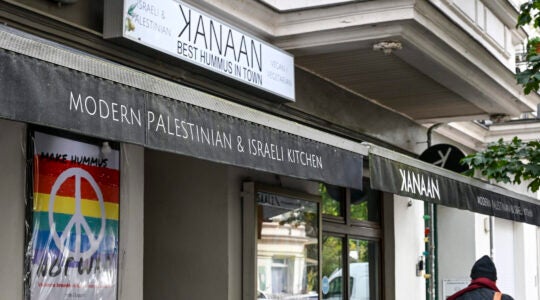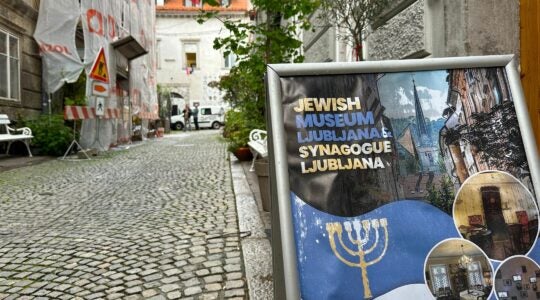VILNIUS, Lithuania (JTA) – Months ago, I decided that, as a loud and insistent partisan on behalf of Yiddish language and culture, I should improve my spoken Yiddish.
It would be this summer or never.
I had just left my job as a corporate attorney and time, if not money, was on my side. I was newly employed as the part-time Internet/outreach/youth-wrangling editor for a Jewish culture and politics magazine with a traditionally Yiddish speaking (intensely, and devoutly secular) readership.
I managed to convince my employers at Jewish Currents that not only was it necessary to spend more than a month in a language immersion program, but also that my trip to Yiddishland would generate plentiful material for upcoming issues.
So off I went to the Vilnius Yiddish Institute’s summer Yiddish program in Vilnius, Lithuania. Vilna – I never referred to it as Vilnius – was a place about which I had sung, read and attended lectures. Last April, I sat in the office of a colleague, a woman much wiser than I, and told her I would be going to Vilna this summer to perfect my understanding of Yiddish case endings. There’s only three, so I figured a month would be enough.
Vilna! Yiddish! Wasn’t it cool?
My colleague looked at me dryly, as only she can. “Vilna is no more,” she said. “There is only Vilnius, babe.”
But for me, and for all my Yiddishist friends, Vilna is a very real place. Vilna was the home of great modernist Yiddish poetry, of important Jewish publishing houses, the birthplace of the YIVO Institute, the resting place of the Vilna Gaon.
For those of us left cold by the clapping and swaying of Upper West Side neo-chasids, the idea of Vilna is a comforting touchstone, home of the traditional opponents of the Chasidim: the Misnagdim.
Although my own family is solidly Romanian, I am regularly in touch with what I call my inner Litvak: the cerebral, slightly aloof Jew who shies away from Friday night swaying at shul.
I was personally offended by the suggestion that Vilna no longer existed.
But my colleague turned out to be right: Vilna is no longer. Today, Vilnius speaks loudly. Jewish Vilna is only a whisper heard by those who care to listen closely. Indeed, the dissonances between Vilna and Vilnius ripple across the country, and the globe.
But first, some clarification. The city we know by its Lithuanian name, Vilnius, once was part of the Polish-Lithuanian Commonwealth. Until the close of World War II, Vilna/Wilno (Yiddish/Polish) was a majority Polish and Yiddish-speaking city. Lithuanian speakers were always a small fraction of its population.
After the war, under Soviet occupation, Vilna became Vilnius. Compared to Lavia and Estonia, Lithuania mostly resisted “Russification” and had a relatively small Russian population.
Lithuania has been independent for less than 20 years and is still in the process of writing its national history – and myths.
The competing histories of Vilna and Vilnius – Lithuanian, Polish and Yiddish – erupted this spring and summer with an international scandal surrounding the Lithuanian ‘investigation’ of Jewish former partisans for their wartime activities.
The offiial conflation of anti-Nazi activity with pro-Soviet collaboration is still alive in Vilnius and lies at the heart of the investigation.
And so, in addition to pondering the difference between the accusative and the dative case, I unexpectedly found myself right in the middle of an international story – my first as a real journalist.
The Vilnius Yiddish Institute sits across the street from the Presidential Palace; you can practically see the changing of the guard from the classroom windows. The institute’s librarian, Fania Brantsovsky, was a partisan during the war and for the past few months has been targeted by the Lithuanian justice system.
Perhaps the fiercest librarian ever to catalog a Yiddish book, I quickly learned that Fania, 86, was not a woman to be intimidated by anything, even a prosecutor’s investigation.
Even among Vilnius’ small remaining Jewish community, Fania is unusual. She was born and raised in Vilnius – many of the approximately 4,500 to 5,000 current Jewish residents were born outside Vilnius. When Fania guides us through the city she takes us to the place where her former school, the Sofia Gurevitch Gymnazia, was located. Sofia Gurevitch was one of the first places to have a telephone. Being chosen to speak on the phone was an honor for the student with the clearest, most pleasant voice. Fania still beams with pride at the memory of being that student.
A few streets over, Fania points to where she and the other partisans emerged from underground. They escaped from the ghetto through the sewers, a daring plan made possible only by the specialized knowledge of another partisan, an engineer.
A few streets later and we see a plaque dedicated to Theodor Herzl, who, we learn, spent a short time in Vilna. But there’s no plaque marking the spot where Fania and her comrades emerged from the sewers to go on to complete many acts of daring sabotage against the Nazis.
The Lithuanian government’s ability to adequately document and preserve the stories of the ghetto and Jewish resistance – and Jewish suffering – is seriously compromised by the continuing official association of anti-Nazi activity with Soviet oppression.
The Museum of Victims of Genocide in downtown Vilnius is housed in an enormous building, the former home of the Lithuanian KGB. Just as chilling as the recreated KGB surveillance mechanism are the museum’s official silences. Ponar, where a large portion of Lithuanian Jewry was murdered, is nowhere to be found among the museum’s genocide victims.
Over the course of three years, some 70,000 Jews were murdered at Ponar, a forest the Nazis used as a death factory, about six miles from Vilnius. Fania also led us through Ponar, she herself a walking monument to resistance and survival.
Fania’s voice remains as strong and clear as it was the day she was chosen to speak on the phone at the Sofia Gurevitch school. But hers is only one voice, too easily drowned out in a still-unsettled political discourse. The anti-Semitic graffiti sprayed across the Vilnius Jewish Community Center on Tisha B’Av didn’t take place in a vacuum.
The official Lithuanian narrative is one that shouts over voices of resistance, such as Fania’s. But my colleagues at the Institute, Jews and non-Jews, from all over the world, including Lithuania, will continue to join our voices with Fania’s, and so ensure that Jewish Vilna continues to have a voice.
JTA has documented Jewish history in real-time for over a century. Keep our journalism strong by joining us in supporting independent, award-winning reporting.





